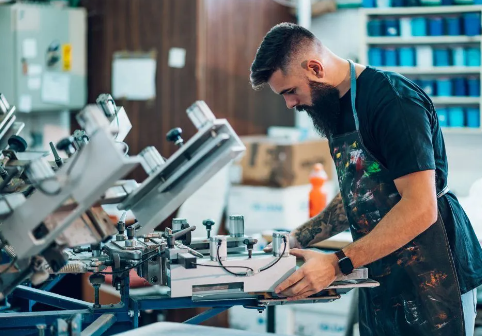Serigraphy, widely known as screen printing, represents a fascinating amalgamation of artistic expression and industrial utility. This printing technique, which involves pushing ink through a mesh screen to create a design, has roots deep in the realms of both high art and commercial production. The versatility of serigraphy has enabled its practitioners to not only create compelling artistic works but also to meet the growing demands of the modern industrial landscape.

The Historical Evolution of Serigraphy
The journey of serigraphy from an artisan craft to a cornerstone of industrial manufacturing spans several centuries and continents. Initially developed in China during the Song Dynasty, this method was primarily used for artistic and decorative purposes. As the technique made its way through Asia and later to Western Europe, its potential for mass production became evident. This section delves into the significant milestones in the evolution of serigraphy, highlighting its transformation and adaptation through time.
Technical Aspects and Innovations in Screen Printing
Serigraphy is distinguished by its unique ability to produce vibrant, multicolored images with high fidelity and durability. This part of the article explores the technical nitty-gritty of screen printing, from the types of screens and inks used to the recent technological advancements that have refined the process. Innovations such as digital screen making and automated presses have revolutionized this field, enabling faster production times and enhanced precision, thus meeting industrial demands more effectively.
Serigraphy in Contemporary Art
Despite its industrial applications, serigraphy remains a beloved technique among artists for its bold aesthetics and the hands-on nature of its process. This segment examines how contemporary artists utilize screen printing to explore and express modern themes, blending traditional techniques with modern narratives. The tactile quality of serigraphy, combined with its capacity for vivid colors and graphic clarity, continues to make it a powerful tool for artistic expression.
Enhanced Versatility of Screen Printing in Commercial Applications
Screen printing’s adaptability stretches far beyond the confines of artistic endeavors, firmly establishing itself as a staple in commercial industries. In the realm of advertising, for instance, serigraphy is pivotal in the production of large-scale billboards and intricate point-of-sale displays. The ability to apply vibrant, weather-resistant inks on diverse materials makes serigraphy an ideal choice for outdoor advertising, where durability against environmental factors is crucial. Furthermore, the automotive industry benefits immensely from screen printing technology, especially in the production of vehicle wraps and detailed dashboard components. These examples underscore serigraphy’s critical role in ensuring both aesthetic appeal and functional longevity in commercial products.
Serigraphy as a Medium of Cultural Expression
The cultural impact of serigraphy extends into realms of public consciousness, serving as a medium for both social commentary and popular expression. Artists like Andy Warhol and Shepard Fairey have utilized screen printing to blend commercial imagery and high art, thereby making profound statements on society and politics. Their works demonstrate how serigraphy can be a powerful tool in shaping cultural narratives, making art accessible and relatable. Moreover, screen printing is often employed in the creation of limited edition concert posters and exclusive apparel, further exemplifying its role in the diffusion of cultural trends and movements. These instances highlight how serigraphy bridges diverse worlds, embedding itself into the fabric of popular culture.
Technological Synergies Elevating Screen Printing Precision
The integration of cutting-edge technologies with traditional screen printing processes has spawned a new era of precision and efficiency. Innovations such as computer-to-screen (CTS) imaging systems have dramatically reduced setup times and improved the accuracy of image placements, crucial for high-volume production settings.
Additionally, advancements in UV-curable inks have not only accelerated the drying process but also enhanced the vibrancy and longevity of prints. These technological synergies signify a leap towards more sustainable practices, reducing waste and energy consumption. As such, the continuous refinement of screen printing technology promises to sustain its indispensability in both artistic and industrial spheres.
Screen Printing’s Role in Modern Industries
Beyond the art studio, serigraphy plays a critical role in various industries, from fashion to electronics. Screen printing is integral in creating everything from bespoke garments to circuit boards, showcasing its versatility and reliability. This part discusses how different sectors leverage the benefits of screen printing, emphasizing its impact on production efficiency and product customization.
The Future of Screen Printing: Trends and Potential
Looking ahead, serigraphy is set to evolve further, driven by advancements in technology and growing environmental concerns. This final section speculates on the future trends in screen printing, including sustainable practices and the integration of AI for design and execution. It also considers the potential for new materials and methods that could further bridge the gap between art and industrial function.
Conclusion
Screen printing, or serigraphy, serves as a prime example of how art and industry can not only coexist but thrive together. By continuously adapting to the needs of both worlds, it maintains its relevance and proves its enduring appeal. As we look to the future, the potential for further innovation in serigraphy is boundless, promising exciting developments at the intersection of creativity and commercial productivity. This unique blend of art and industry highlights the multifaceted nature of serigraphy, making it a field rich with opportunities for exploration and growth.




